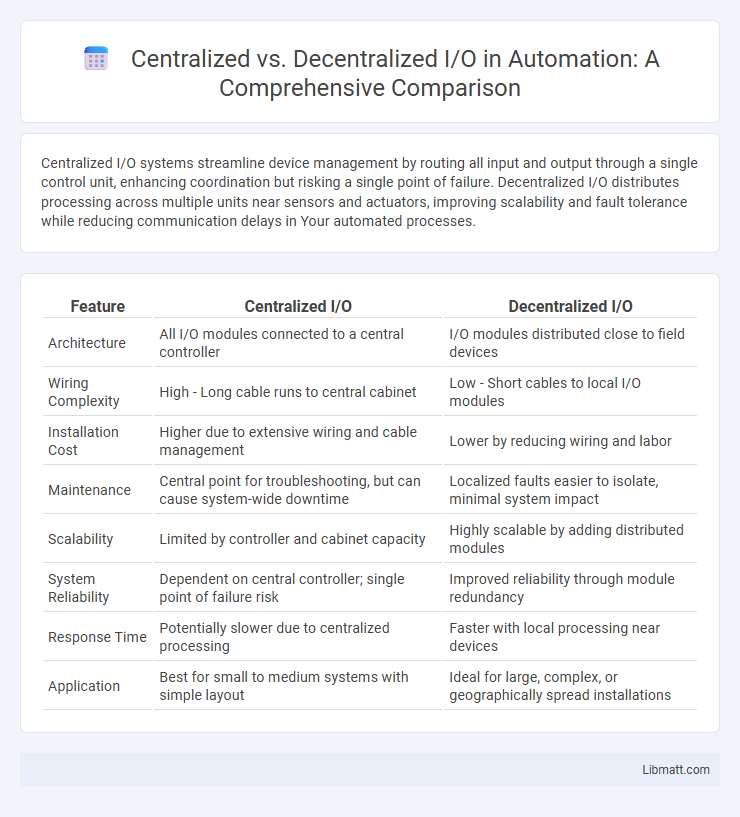Centralized I/O systems streamline device management by routing all input and output through a single control unit, enhancing coordination but risking a single point of failure. Decentralized I/O distributes processing across multiple units near sensors and actuators, improving scalability and fault tolerance while reducing communication delays in Your automated processes.
Table of Comparison
| Feature | Centralized I/O | Decentralized I/O |
|---|---|---|
| Architecture | All I/O modules connected to a central controller | I/O modules distributed close to field devices |
| Wiring Complexity | High - Long cable runs to central cabinet | Low - Short cables to local I/O modules |
| Installation Cost | Higher due to extensive wiring and cable management | Lower by reducing wiring and labor |
| Maintenance | Central point for troubleshooting, but can cause system-wide downtime | Localized faults easier to isolate, minimal system impact |
| Scalability | Limited by controller and cabinet capacity | Highly scalable by adding distributed modules |
| System Reliability | Dependent on central controller; single point of failure risk | Improved reliability through module redundancy |
| Response Time | Potentially slower due to centralized processing | Faster with local processing near devices |
| Application | Best for small to medium systems with simple layout | Ideal for large, complex, or geographically spread installations |
Introduction to Centralized and Decentralized I/O
Centralized I/O systems consolidate input and output processing within a single controller or unit, streamlining data management and simplifying system architecture. Decentralized I/O distributes control across multiple nodes or devices, offering enhanced scalability, flexibility, and resilience in complex or large-scale environments. Choosing between centralized and decentralized I/O architectures depends on factors such as system size, latency requirements, processing power, and fault tolerance needs.
Core Concepts of Centralized I/O Systems
Centralized I/O systems consolidate input and output operations through a single control unit, enhancing management simplicity and consistency across devices. These systems rely on a central processor to coordinate data flow, minimizing redundancy and fostering streamlined communication pathways. Centralized control facilitates easier troubleshooting, centralized resource allocation, and uniform protocol enforcement in network architectures.
Key Principles of Decentralized I/O Architectures
Decentralized I/O architectures distribute control and processing closer to the field devices, enhancing system scalability and reducing latency. These systems rely on localized controllers and smart sensors that communicate with central systems via network protocols such as Ethernet/IP, PROFINET, or Modbus TCP. This approach improves fault tolerance, simplifies maintenance, and enables real-time data processing for Industrial Internet of Things (IIoT) applications.
Comparative Analysis: Centralized vs Decentralized I/O
Centralized I/O systems consolidate input and output processing in a single control unit, enhancing simplicity and ease of management but potentially creating bottlenecks and single points of failure. Decentralized I/O distributes processing across multiple nodes or devices, improving system scalability, fault tolerance, and response times by localizing data handling closer to sensors and actuators. Performance efficiency, network traffic, cost implications, and application-specific requirements are critical factors influencing the choice between centralized and decentralized I/O architectures.
Performance and Scalability Considerations
Centralized I/O systems often provide lower latency and simpler management, making them suitable for environments with moderate performance demands, but they can become bottlenecks as system scale increases. Decentralized I/O architectures enhance scalability by distributing processing closer to data sources, reducing network congestion and improving throughput for high-demand applications. Your choice between centralized and decentralized I/O should weigh the trade-off between initial performance simplicity and long-term scalability requirements to ensure optimal system efficiency.
Security Implications of Both I/O Approaches
Centralized I/O systems offer enhanced security through uniform access controls and simplified monitoring, reducing the attack surface by consolidating data flow points. Decentralized I/O architectures distribute processing and storage, which can improve resilience against targeted attacks but require robust, localized security measures to prevent vulnerabilities across multiple nodes. Balancing centralized oversight with decentralized autonomy is critical for maintaining data integrity and mitigating risks in complex network environments.
Cost Efficiency and Resource Management
Centralized I/O systems reduce hardware expenses by consolidating control units, leading to lower installation and maintenance costs. Decentralized I/O offers improved resource management through distributed processing, which minimizes data bottlenecks and enhances system scalability. Cost efficiency favors centralized I/O in smaller setups, while decentralized I/O excels in large-scale environments requiring flexible resource allocation.
Real-World Applications and Use Cases
Centralized I/O systems excel in manufacturing plants and data centers where tight control and simplified maintenance are critical, providing streamlined data collection and consistent system management. Decentralized I/O is preferred in large-scale automation projects and smart grids, enabling distributed data processing, enhanced scalability, and reduced wiring complexity across extensive geographic locations. In industrial automation, decentralized I/O supports modular production lines, while centralized I/O is favored in environments demanding robust data integrity and immediate system-wide responses.
Common Challenges and Pitfalls
Centralized I/O systems often face challenges such as single points of failure, limited scalability, and increased latency due to long communication paths. Decentralized I/O architectures may encounter difficulties with synchronization, complex network management, and increased hardware costs for distributed controllers. Both approaches require careful design to mitigate risks related to reliability, maintainability, and real-time data processing efficiency.
Choosing the Right I/O Design for Your Needs
Choosing the right I/O design depends on factors such as system scalability, performance, and fault tolerance. Centralized I/O offers simplified management and lower latency for smaller systems, while decentralized I/O excels in large, distributed architectures requiring enhanced reliability and modular expansion. Assess your application's load and connectivity demands to determine whether centralized control or distributed processing better aligns with your operational goals.
Centralized vs Decentralized I/O Infographic

 libmatt.com
libmatt.com